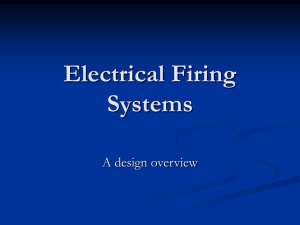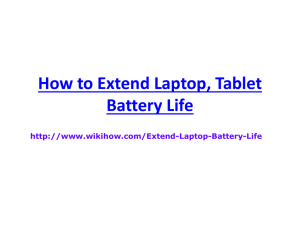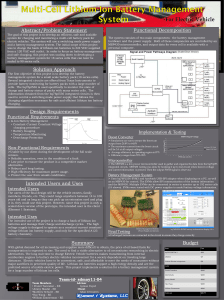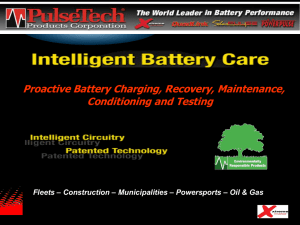batteries lecture
advertisement
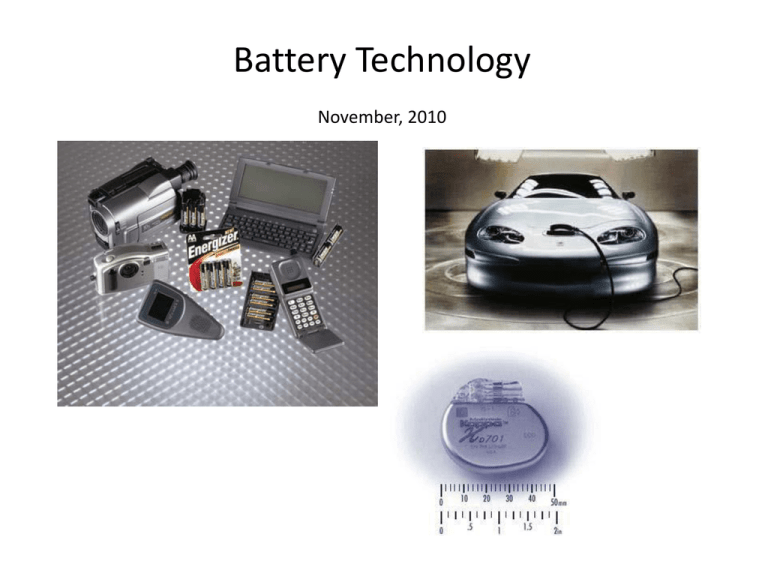
Battery Technology November, 2010 Problems with EV propulsion 1. range: function of energy density of the battery. Compare gasoline @ 12,000 (theo.) / 2600 Wh/kg with the lead-acid battery @ 175 (theo.) / 35 Wh/kg 2. time to refuel: charge 40 kWh in 5 minutes? 220 V × 2200 A!!! When you pump gasoline @ 20 /min, your energy transfer rate is about 10 MW! (Hint: energy density of gasoline is 10 kWhth/.) 3. cost: (a) light but safe means higher materials costs, e.g., less steel, more aluminum; and higher processing costs, e.g., fewer castings, more forgings... (b) to reduce load on the battery requires high efficiency appliances = costly (c) low cycle life — batteries priced @ $4,000 to $8,000 lasting about 2 years Specific Energies of Battery Chemistries lead acid NiCd NaS NiMH Li ion gasoline (Wh/kg) 35 45 80 90 150 12,000 (MJ/kg) 0.13 0.16 0.28 0.32 0.54 43 NOTE: 1 Wh/kg storage capacity equals about 1 mile driving range Battery Basics what is a battery? a device for exploiting chemical energy to perform electrical work i.e., an electrochemical power source the design paradigm? choose a chemical reaction with a large driving force (ΔG) and fast kinetics to cause the reaction to occur by steps involving electron transfer Types of lead-acid batteries 1. Car battery “SLI” - starter lighting ignition Designed to provide short burst of high current Maybe 500 A to crank engine Cannot handle “deep discharge” applications Typical lifetime of 500 cycles at 20% depth of discharge 2. Deep discharge battery More rugged construction Bigger, thicker electrodes Calcium (and others) alloy: stronger plates while maintaining low leakage current More space below electrodes for accumulation of debris before plates are shorted 3. “Golf cart” or “forklift” batteries Similar to #2 Bigger, very rugged, Low cost — established industry Antimony alloy, Strong big electrodes But more leakage current than #2 Can last 10-20 years AGM Battery Lithium Ion Battery Tesla Battery The pack weighs 990 pounds, stores 56 kWh of electric energy, and delivers up to 215 kW of electric power, 375 volts. Battery cost is about $30,000 Each cell is 18mm in diameter by 65mm length, The small cell size enables efficient heat transfer, allows for precise charge management, improves reliability, and extends battery pack life. Each cell is enclosed in a steel case which effectively transfers heat away from the cell. The small size makes the cell essentially isothermal, and its large surface area allows it to shed heat to the ambient environment. Sixty-nine cells are wired in parallel to create bricks. Ninety-nine bricks are connected in series to create sheets, and 11 sheets are inserted into the pack casing. In total, this creates a pack made up of 6,831 cells. Charge management (lead acid) Over-discharge leads to “sulfation” and the battery is ruined. The reaction becomes irreversible when the size of the lead-sulfate formations become too large Overcharging causes other undesirable reactions to occur Electrolysis of water and generation of hydrogen gas (explosive) Electrolysis of other compounds in electrodes and electrolyte, which can generate poisonous gasses Bulging and deformation of cases of sealed batteries Battery charge management to extend life of battery: Limit depth of discharge When charged but not used, employ “float” mode to prevent leakage currents from discharging battery Pulsing to break up chunks of lead sulfate Trickle charging to equalize charges of series-connected cells Charge profile A typical good charge profile: Bulk charging at maximum power Terminate when battery is 80% charged (when a voltage set point is reached) Charging at constant voltage The current will decrease This reduces gassing and improves charge efficiency “Absorption” or “taper charging” Trickle charging / float mode Equalizes the charge on series-connected cells without significant gassing Prevents discharging of battery by leakage currents Occasional pulsing helps reverse sulfation of electrodes A 12v automotive battery is actually made up of cells… Power Configurations In series In Parallel My EV bug is a 72V system, 6 x 12v batteries in series… Specifications & Performance: http://evw.tech.purdue.edu Drive system: 72 volts (lead acid) Top Speed: 40 mph Distance: 25 miles Cost: $5,000 (total) Vehicle: $1,500 Batteries: $700 Electronics: $2,000 Batt Chargers: $500 Mechanical: $300 Assignment (email answer to mdkane@purdue.edu) Explain the TOTAL impact of adding an additional 6 (12V) batteries… 1) 2) 3) In Series (144V system) In Parallel (to the existing battery set, remains a 72V system) As a secondary drive system Consider (a) vehicle performance, (b) needed electrical component upgrades, (c) mechanical considerations





